
I have just come back from one of the most amazing motorcycle trips and wanted to share my experiences. I am a new rider – got my first bike some 10 months ago – so also wanted to share what I learned with alike riders. This is not a sponsored article and it expresses my personal views.
Comments section is open below.
The full map also available at the end of the post.
Day 0: bike transport from Muscat to Salalah
Contents
My initial plan was to ride from Muscat all the way to Salalah and back (around 3000 km), but then I realised it would be too much especially that I am a new rider and will be going solo. Fortunately, it is very common to move your vehicle from Muscat to Salalah on a tow truck, so I flew and used one of the local towing companies to move my bike. The trip eventually took about 2100 km, so probably I would have made it. Anyway good to know for the next adventure!
The problem with all those towing companies is that they don’t speak English much, so I had to ask one of my Omani friends – Thanks Majid – to help me out. He checked around and found ‘a good one’ that also provides insurance. With high expectations I arrived at the received WhatsApp location looking for their office, instead there was just a place with tow trucks parked around.
Tip: have a picture of their tow truck on your phone so you can show it to people what you are looking for. It is good that I did a few hills before as I had to ride up that steep ramp by myself.
Having a quick thought about what’s the best way to secure my bike, I decided to tie up wheels only and let it float on its own suspension. Had I attached it by the frame, it would probably be bouncing up and down under tensioned straps. Also wheels are pretty strong, so no worries anything would be damaged. Strap the bike yourself as they may allow the strap to create some tension on some plastics that later on you may find broken. I also put my riding gear in a big bag which they kept in the storage box under the bike. This made my travel by airplane smooth with only soft rear bag as carry-on luggage.


The Pakistani tow truck driver spoke no English but fortunately a gentleman called Ahmed in his Nissan behind me helped me translating when I asked for insurance policy. Forget it! The only thing you sign is a receipt having your bike details and your ID. Terms and Conditions are unwritten or at least not shown to the customer. I think there is a lot of potential to improve customer services around different places here.
Another problem was the date of the shipment. Long story short – I landed in Salalah on Friday and my bike left Muscat prior Sunday and arrived in Salalah on Tuesday, so they had to store it somewhere for 3 nights. On Tuesday evening around 9pm a guy from Salalah calls me and asks me: where are you? Come and pick up your bike? The bike is not safe here, come and pick it. F***ing great – I thought. So I called around my friends: do you have anyone in Salalah where I could store my bike for a couple of nights… but no luck. Then I called Ahmed whose car was already in Salalah to see if he can do something. He called the boss of the towing company and made it clear to them that it is their responsibility and if anything goes wrong with the bike it will be on them. After that the bike was secured in a garage under the roof – thanks Ahmed for helping out again. The problem got solved as quickly as it appeared.
The reason the bike was shipped too early was because they guy in Muscat wants to make sure each of his transports is full, so he takes as many vehicles as quickly as he can and the guy in Salalah is not aware of what the Muscat guys is doing.
I noticed being helped by strangers in Oman is common – you don’t even need to ask.
After securing my bike on the tow truck Ahmed gave me a lift back to my house (around 40 mins drive!) on the way back we branched off to his father house for Omani coffee and dates. Without even talking to his people at home he said ‘my father invites you to his place’ – I have been to many places, but I think such hospitality is unique to Oman and it is not only a surface slogan, but it comes deeply from themselves – it is just the way they are. It turned out his father was the first driller in Oman, unfortunately I didn’t get to know him, but we had the Omani coffee with some meat and then 2 hours later I was back at home waiting till Friday for the adventure to start!
Day 1: Salalah to Dhalqut
The moment my airplane touched the ground in Salalah, Ahmed called me and offered help finding my bike. He picked me up from the airport (while – what I found out later – his family were waiting for him to take them for breakfast) and we went to look for the place. The location is something like Marbella in Muscat, but smaller and with its own flavour. We spent quite some time looking for the place the bike was stored because the Salalah guy sent us wrong WhatsApp location. I think the problem was for the guy to send the location of the place without actually being there (you have to first go to Google maps find the location and then share) so instead he sent us a photograph of the place. With that picture in front of us on our phones and half an hour driving around we eventually found the place.
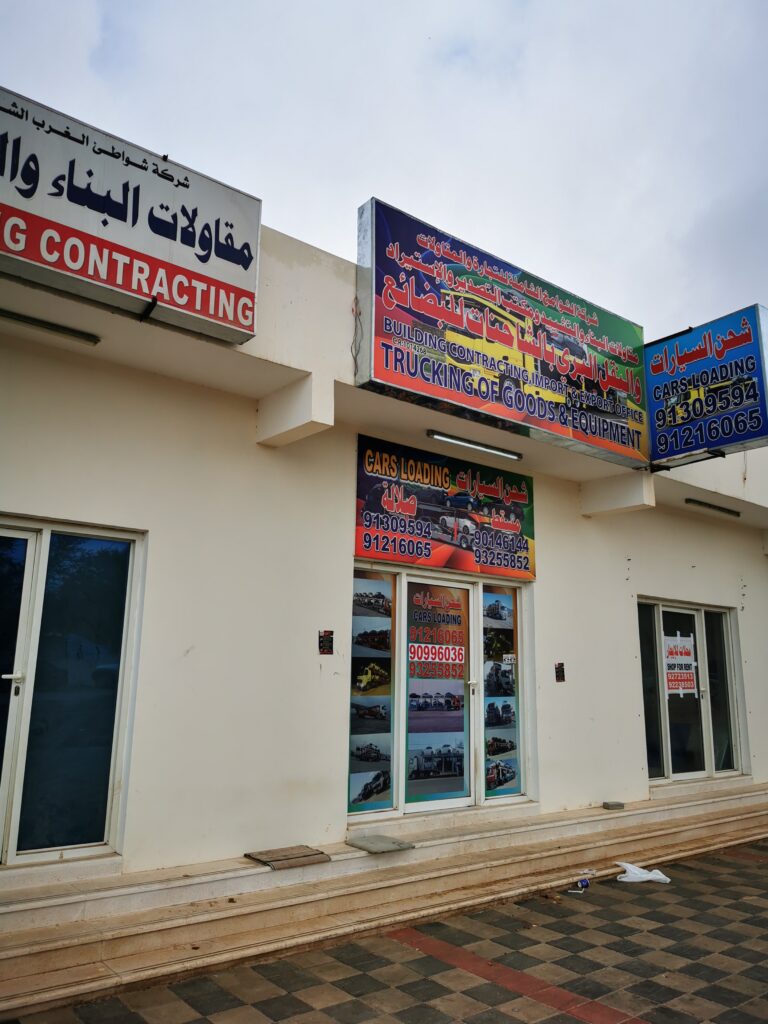
Then I had to wait for about 1 hours before the right guy turned up with the key. I landed at 09:20 and around 11:30 was finally on my bike riding towards Salalah Mountains. My thinking was to do multiple loops in Salalah mountains – weather permitting. What it turned out to be was just a single loop due to dense fog and rain in the mountains.
Here is the loop
Just before reaching the mountains there was a first encounter with camels crossing the highway. Not sure this is visible on the pictures, but there were like 100 of them – amazing view.


I don’t have the picture of that, but shortly after turning inland there was a place with series of stands selling camel meat with all of it hanging just like that on hooks on display. Above each stand there was a sign ‘Restaurant’, I continued riding.
Salalah was dry and with good visibility. This does not mean, however it was not slippery. What you have in this region is a continuous high humidity – like a small drizzle that mixes with very fine sand and covers the surfaces, as result the roads may sometimes become very slippery – more so than you would expect had it just been raining.
What I learned so far riding on a bike is a lot about anticipating and minimising risk, so with that in mind I kept cruising but maintaining safe distance and speed. Overall, during the entire trip I only had one emergency breaking when a car in front of me suddenly stopped in the dense fog – I was going in the ‘RAIN’ mode, so the wheel did not slip, but it made my breaking distance a bit longer and I had to by pass the car to the right to avoid bumping into it. Again, I had enough time and space to do that as I was going relatively slowly.


Some people may say it is not the best time to go to Salalah and ride on a motorbike during such conditions – fog, rain, wind all three at the same time – but I am of the opinion that it is all about getting the experience and learning from it. At the end you don’t have control over the weather so you may have best plans, but still be surprised by the conditions and if you had experience with it at least you are more prepared. Another way of looking at it: you are not limiting yourself to what weather tells you to do but to what is that you want to do! It would be great to hear others’ views on this.
Having done one 140km loop was enough and I headed further south to Yemeni border to a place called Dhalqut.
Dhalquit is about 150 km from Salalah. It started with clear visibility on longer stretches, but later it was a mix of heavy fog with moderate visibility, but much more drier than in Salalah mountains, however more windy. Despite long stretches of straight road, due to low visibility, I had to go relatively slowly and it took me almost 3 hours to reach there, including stopping at 2 army check points. Just before Dhalqut the road was going down off the mountains, so it was quite curvy with some animals strolling along – more on that in Day 2.


I reached Dhalqut at around 5pm and prayed their gas station had fuel – Ahmed warned me that some places in the south run out of fuel occasionally. Fortunately, the only gas station in town was open and had gasoline. The gas station was within police premises. I suspect due to remote location security of fuel supply supported by the government.

It was the first time I put octane 91 gasoline into my bike but I was very happy I could put anything in!
Believe it or not but they have an HSBC branch in Dhalqut – I was really surprised to see it there in such a small and remote place – but apparently there is a reason it is needed there.
Tired, had some food – there are 2 or 3 local restaurants – I reached Dhalqut Hotel completely wet, fell asleep and was woken up next day 6am in the morning by 4 gunshots… it was a start of Day 2.

Day 2: Dhalqut to Sadah
The gun shots put me straight up instantly, with half dreaming my first reaction was – is my bike safe! Then having glanced through the window and seeing that nothing was happening, I realized that since it was beginning of Muslim Eid al-Adha (“Feast of Sacrifice”) holiday, the gunshots were either in celebration of the holiday itself or maybe to sacrifice a goat. Anyway, with eyes wide open, I put on (still wet) gear and hit the road. Most of the times I did not have breakfast at the places I slept, as I wanted to start riding as early as possible and then was trying to find some food along the road.
Before I came to Salalah my thinking was to do this 68 km section:
Although it shows on Google Maps that it crosses the Yemeni border, if you look closer at the satellite map it does not. However, I had to abandon this plan as I knew the conditions will be difficult (mountain terrain wet and foggy as in Salalah mountains perhaps) and also it was pretty remote, so not sure mobile reception was there in case I needed to call for help. Nevertheless, it looks like an amazing route for a motorcycle, so maybe next time when I am not going solo and the weather is better! If someone knows this route please share more details – is it black top or gravel?
So I went back the same road as the day before, however this time the visibility was much better and I could go faster, especially on straights.
When taking a photo at Wadi Sayq I was met by two Omanis who offered me Omani coffee – it was warm and smelled lovely – still being wet I enjoyed every sip of it. The usual question I often get is: where do you come from? When they hear Poland they either go on to Lewandowski or mention Zakopane! It turned out one of this folks was actually in Zakopane – although it took him some time to say it in way I could get it. Again Omani hospitality at heart.


Where do you come from? It is actually a very weird question. Whenever I am asked this question I always ask myself: do they mean the place I was born in? Do they mean where I am traveling from? Do they mean where I currently live? Most of the times people mean where is the place you were born in? But with all this movement of people around the world does it really matter the place you were born in? One of the reasons people ask this question I think is because they have a mental drawer in mind about certain group of people and they want to put you in that drawer so they ‘know’ who they are dealing with. Ooh once he/she was born in that country he/she needs to be this and that, educated and in this way and represent such culture. In a way it is a confirmation bias – you look for evidence that supports your mental model. Anyway, it is always nice being asked that question but I don’t think the answer to it really matters especially during todays’ so much mixed society.

While still close to Dhaqut the fog was on and off, but this time more animals strolling on the road. Again with this low visibility I had to go really slow. You ride and suddenly just in front of you there was a cow or a camel. Interesting experience – they were just appearing out of nowhere!
A bit further, the visibility improved and there were more Camels – I think in these mountain areas camels simply use the road – like others – to move between places, so don’t just suspect they will be there – it is guaranteed! I saw plenty of them. I always tried to be careful not to scare any animals but I noticed camels are much more timid than cows and may react faster. Not sure if it was because of their size but I always felt a bit uncertain when passing by camels.
A bit further the road climbed up and I was above the clouds.




I continued to Cave Marneef which is famous for its Blow Holes – holes connecting the cave to the sea which during rough weather gives a geyser like effect. Nice to see once. Since I did not eat anything yet and it was almost 10am, I said let me try that instant noodles crap – hey it is hot and I will only eat it once (by the way I saw a video somewhere that some of those noodles are actually not digestible by our body – it is not food actually). I paid 1 omr for it and the guy put warm water into it instead of boiling hot one to make the noodles soft. I think their boiling pot could only raise the temperature to some 70-80C. I said: can you please add boiling hot water into it? So the guy took a paper cup and scooped some water from the same pot and added more to my noodles. He did not want to make the customer unhappy not being able to provide hot water so did what he could. I gave them the noodles back and let them keep the money. I was happy as I did not want it anyway.

The original road at Wadi Ashawq is damaged, so I went to check it out. It is good I did it, as I was able to take this beautiful shot.

Here is the location the shot was taken: https://goo.gl/maps/e5z1L9Sv1gjfkatC6
I think this picture summarises that part of the country during this period – wet, foggy, unknown, a bit mystical – beautiful. With easy ride I soon after reached back to Salalah.
After some small shopping in Gardens Mall in Salalah and some good breakfast with coffee at Kaldi I continued.
By the way the shopping mall was almost empty. At Carrefour, there were maybe five people in total. I thought why build such a mall if there is no demand – but I think it makes up for lost revenue during the high tourist season.

The first place I stopped after Salalah was Mirbat, see photos below. It was a bit strange experience. Some of the buildings looked relatively new but a lot of them looked like ancient ones and a lot of them were damaged, possibly by water.



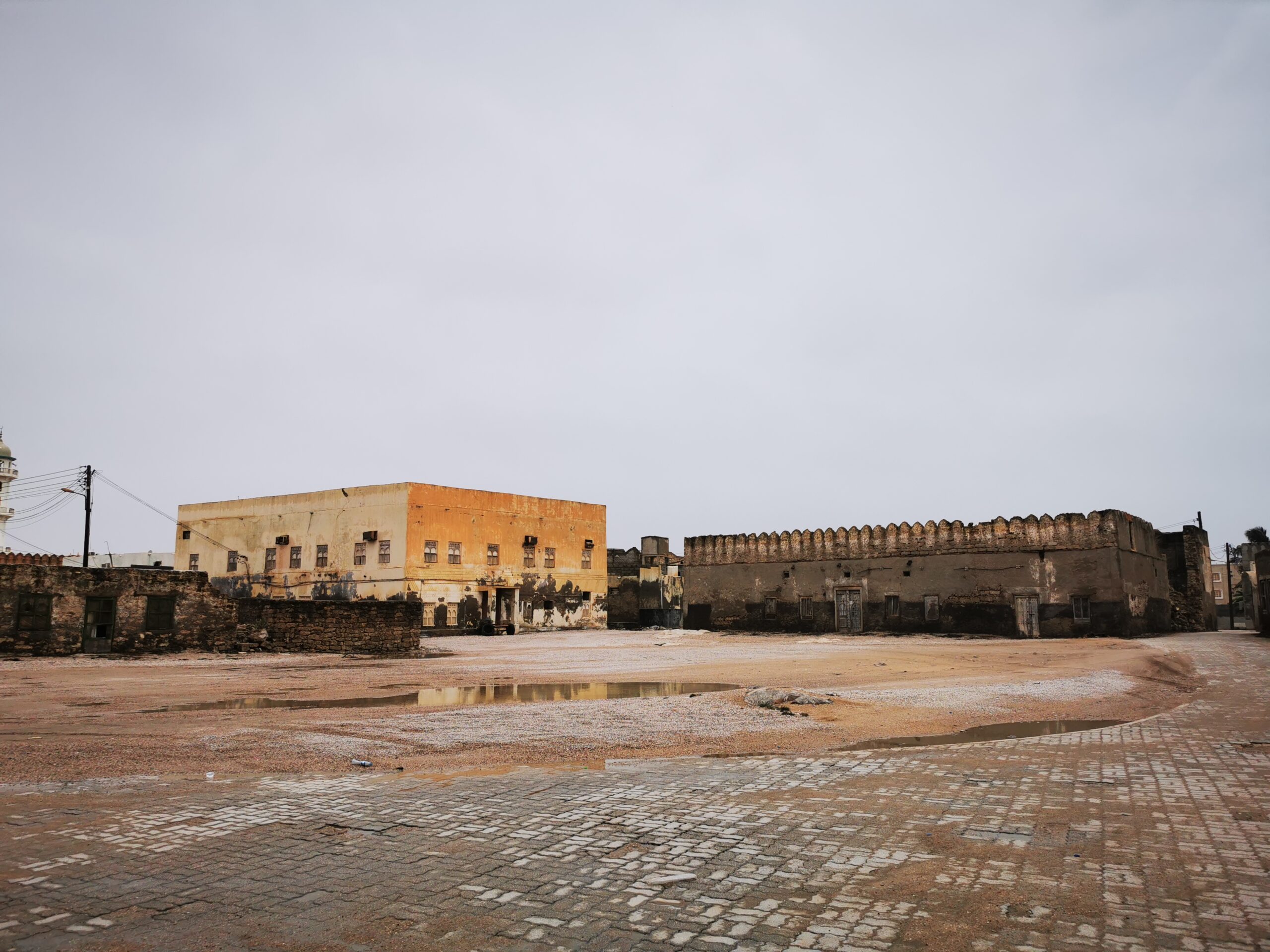

I stopped a few times before Sadah to go offroad (for detail see the track from the BMW Motorrad app at the end). That is a great thing about the adventure bikes: they are both Geland and Strasse. I just love this flexibility, you like something you go there and you know you can, you are free!





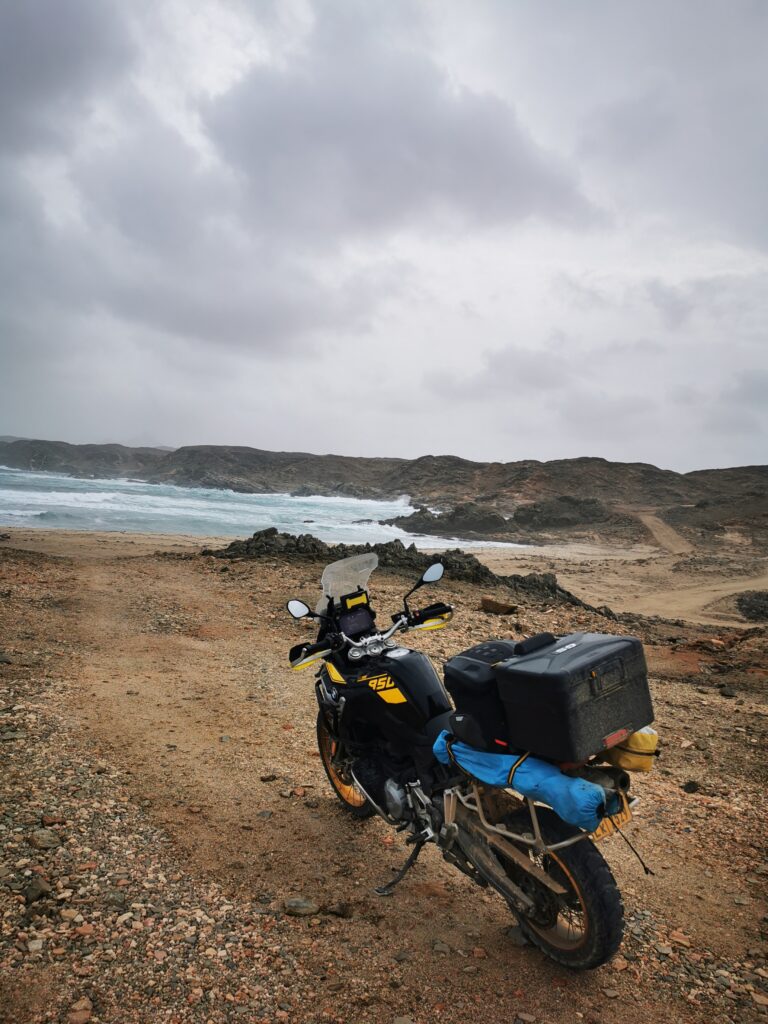

After checking-in in Sadah hotel (more about it later) I could not resist to practice some wheels spinning on the beach there (practice that turned out to be particularly useful … on Day 4).
My experience with riding on sand is very limited, but I like to keep trying it as falls are always soft and it is easy loose the traction. I think it is something you just need to keep practicing until you feel it. My bike weighs 220 kg on its own, with me and all the gear including accessories and with luggage in total I think it can easily get up to 350 kg. At the beginning I did not believe with this weight it is possible at all to move in sand – just physically with that mass over the wheels surface area would create always enough pressure for the wheels to sink – that was my thinking before I tried. Also I asked one of the BMW instructors when they were here in Oman end of last year to give basic off-road training – thanks again Sabah for organising it – and the guys said it is possible. That made me to keep trying.
From what I see so far, riding on sand is all about the right speed and steady input. If you keep throttling it, the wheel will just dig in faster than it goes forward. To feel that balance depending on the depth of the sand and your total weight and the bike you ride I think it is an art. My current problem is that I still give it too much input as I don’t want to slow down to get stuck, but I feel I’m overdoing it at the moment. For sure, there are tons of other stuff I am doing wrong, but again it is about experiencing it and learning from it. And it is a great fun too, not mentioning a good workout. Below is the beach track from that afternoon from the BMW App and some photos – yes there is always falls on sand – but that’s ok. At some point I unloaded the bike and took off the gear it was even more fun.



Doing sand on a motorcycle really gets you tired especially when you are learning and put a lot of energy into it. Next hotel was too far and I was wasted, so I stayed at Sadah Hotel. Very basic facilities, but the bed was quite comfortable. I also had some food – I was happy I took some take away with me from Salalah Grand Mall. The only thing I really did not like was the fact that they did not have towels and for 15 Rials you would expect that – that was the only place with no towels during the entire trip!



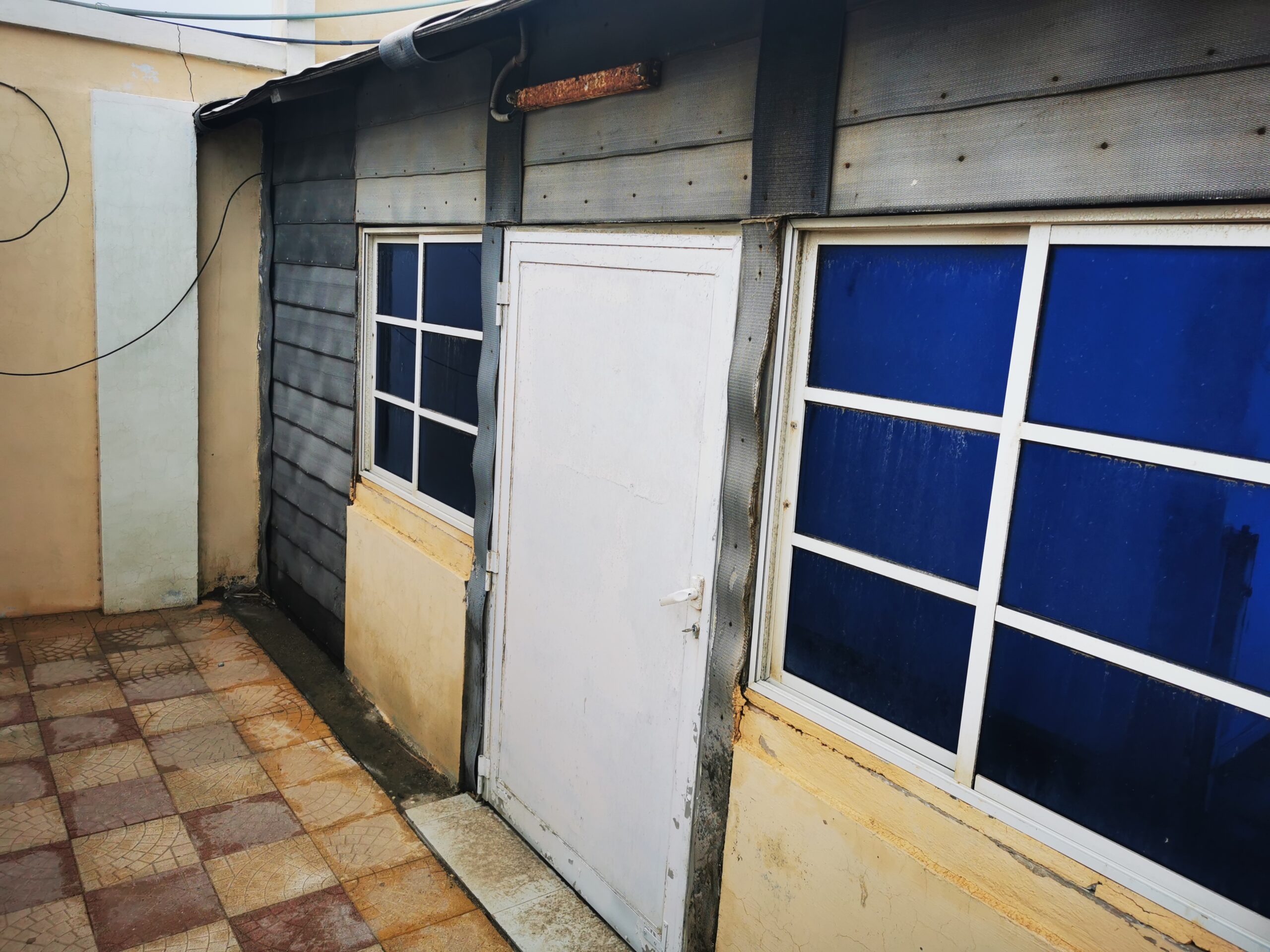
After having food, I took a walk along the coast and found three Omani’s stranded with their Renault Duster broken. They asked me if I can help. It turned out they dropped their car key in water and the immobilizer was not picking the key preventing the car from starting. I took the key and dried it with my hair dryer – I got one in Careffour to dry all my clothes after Salalah. Did that, but the car did not start. The key battery was good. Suddenly, some Indian guys came out of the blue and after some 15 minutes they got it to work – no clue how they did it, but good for the guys otherwise they would be stuck there over night.
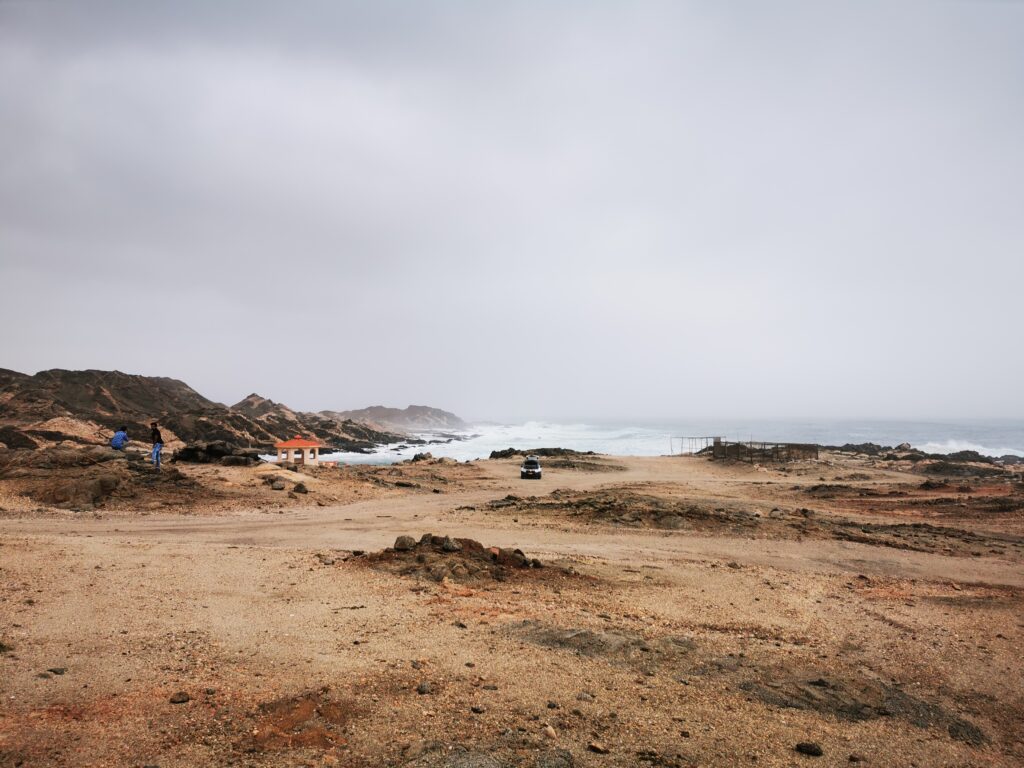
Then I continued walking and met another Omani guy I think his name was Khalid. He told me in English that he is not speaking English and learns it from watching YouTube videos. We talked for 15 minutes about life and laughed a lot. He told me it is very easy to catch fish here, you just need to throw it and the fish will come. Then he went back to his car searched some of his bags and gave me a large sea shell – ‘This is a gift from me from this place, take it’. I did not want to take it but he insisted. Again Omani hospitality at work.


I don’t know what it is, but on the way back to the hotel I found a lot of dead fish on the beach – I think they are called puffer fish. Later on I saw it in other places too. I wonder why would that be? Maybe it swims along the coast and, unlike other fish, its spikes get it stuck in sea weed or on the debris around the beach. Something to find out more about perhaps.

That was the end of the day in Sadah.
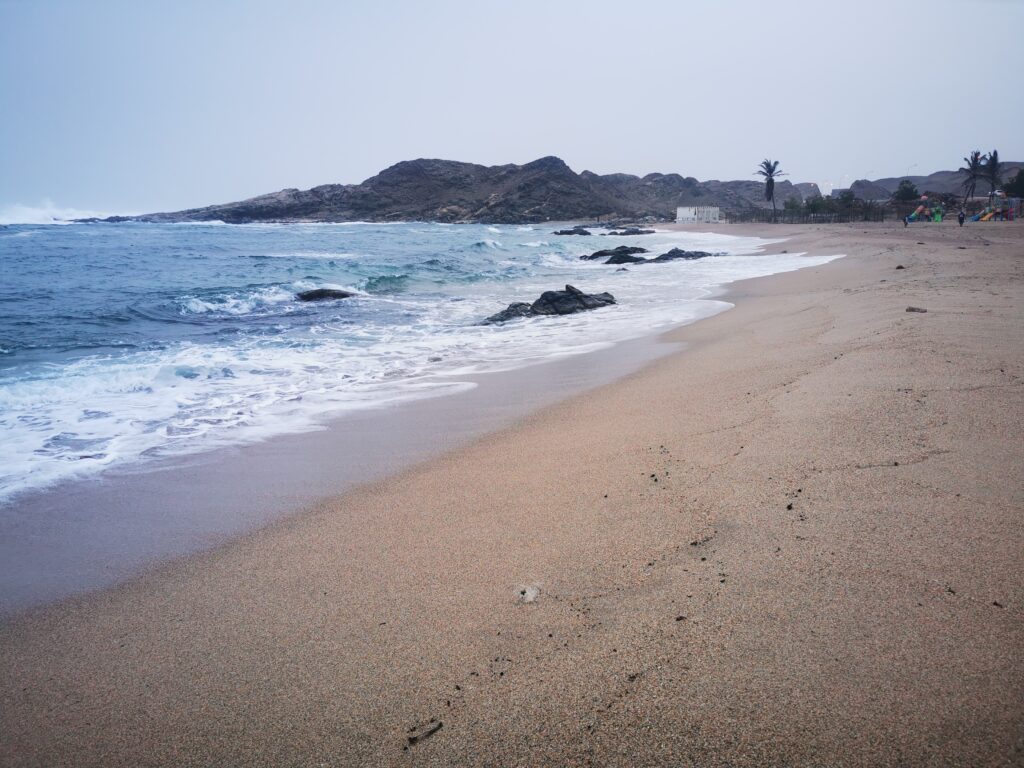
Before going to bed though, I dried all my clothes as I expected no more rain going forward.

Day 3: Sadah to Duqm
I woke up quite early with a lot of muscle pain, but opened the door and look who was waiting there for me…

This is also the first time I put the gel pad on the seat which helped a lot. I still had ass-pancake on the last day which was about 510 km day, but I think the mat did help. Overall, my approach was to take breaks, stop for pictures, talk to people and experience the locations. I did not have unlimited time, but was also not in a hurry. I did not really have a plan for more than just the next day and was taking things as they were happening. Because frequent breaks – I tried to stop after about 2 hours riding – I did not have any serious discomfort at the end.
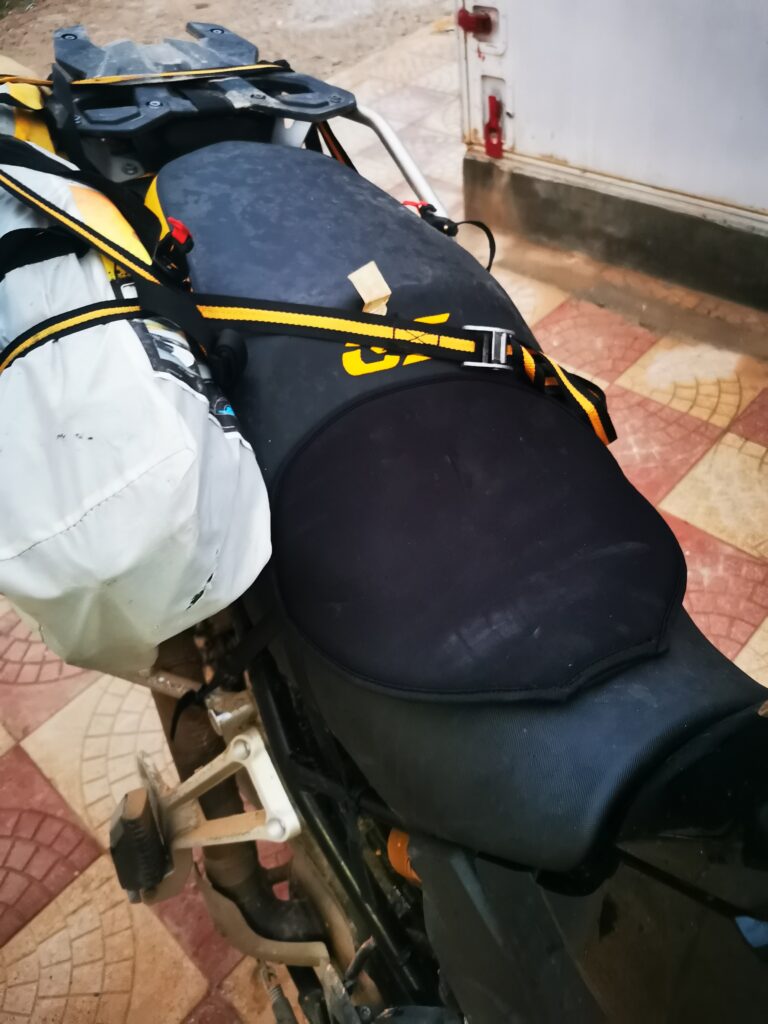
This was going to be a long day, so I went.
Here is some footage along the route from Sadah








Here is a place I found a nice view but as I stopped I lost balance as it was at a slope and bike fell down – a stupid mistake – but again it is all about learning.

Bike fell down with hill, so I first had to rotate it, so the gravity works with and not against me. By the way, I armed my bike such that when it falls nothing will break so I never have to worry when it falls down. It was anchoring on the passenger foot peg, so it was surprisingly easy to rotate. The ground was asphalt which helped too. Then I had to unload the luggage (top case and rear bag – tent and chair always stayed as they are not that heavy and require extra work to disconnect) and managed to put the bike back up on its wheels. Unloading your luggage quickly without too much untangling was very useful (not only this time but also later on) – just a few clicks and with short move it was off. Small things but important, especially when you find yourself in the sun or have to do it a few times. I tried, but without unloading the luggage I was not able to lift my bike even with the help of the slope.
I continued on the road and encountered yet another army check point (number 3 since Dhalqut) – no photography allowed. They just check for your vehicle card, passport and driving licence. We spent a few minutes talking with a soldier there, he got inspired and said he will also do the same route on his Suzuki Hayabusa!
After crossing a small mountain range a longer plane emerged with great views.


The wind began to pick up. The road between Sadah and Ash Shuwaymiyyah is one of the most scenic ones I’ve ever seen. It is also one of the windiest places – more on what I learned riding a motorcycle in wind at the end of Day 3.
In Ash Shuwaymiyyah I was looking for the ‘famous’ Yemeni restaurant, but no luck so I ended up eating breakfast at a small place by the gas station.


The breakfast at the gas station turned out to be very tasty, scrambled egg with crushed Omani chips wrapped in paratha bread. It was so good I had two of them. I learned that Paratha bread is prevalent throughout India, Pakistan, Nepal and Bangladesh. Overall, in all the small places I have found that a lot of people are from those countries.

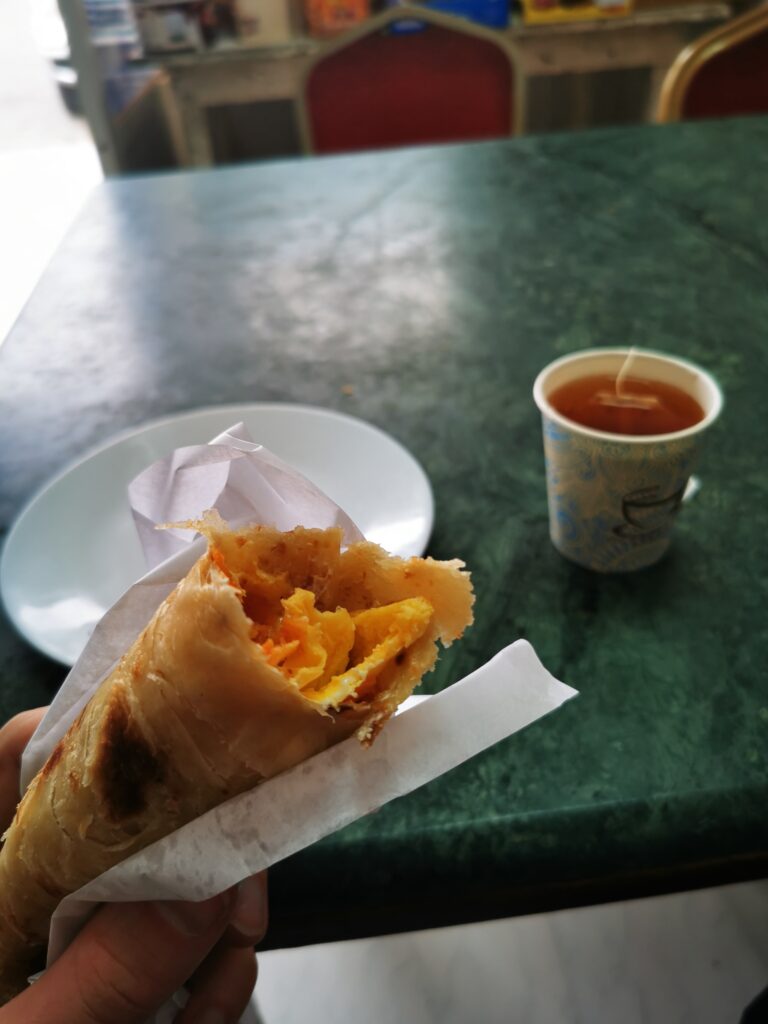

While I was eating a young kid came over and saddled my bike – not that I had anything against that, but he could have just ask first…
I topped up the fuel hoping no corrosion flakes end up in the tank from the pump and continued.


Overall, there is no need to take any extra fuel tanks on this route, I think. My bike holds enough fuel for 250-300 km, and there was always a gas station within that range along the route. At some point, I bought a 5L water to use the bottle for extra fuel but it was not needed at all.
My next route was an inspiration from my dear friends Artur and Darek who went to Salalah last year on their GS-eses in about the same duration, but they did it both ways! Anyway, the idea was to go off the main road via Miji.
Here is the detour:
The first realisation was that it was a gravel road. Again thinking of risk – if it was not possible to pass I could always turn back – I also had plenty of fuel. So I went, every now and then noticing water entering the road, but it was still passable so I continued.


The road slowly began to be more hilly, but also more stable with less water.
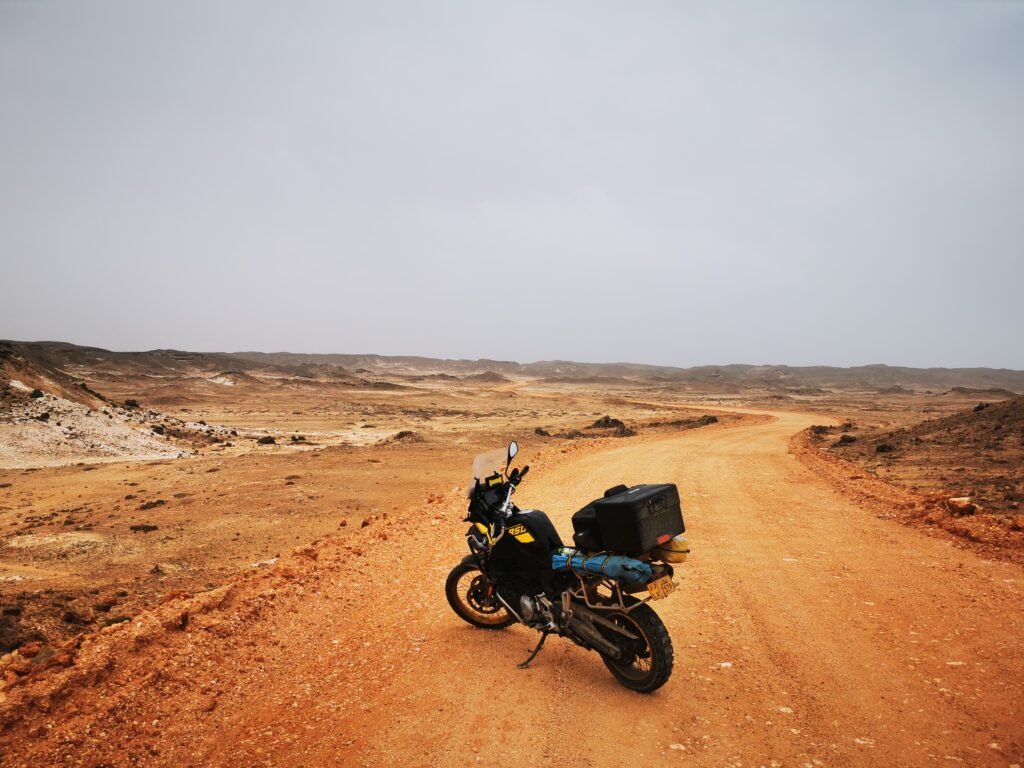
Then, I reached a point of next decision – a little section of the black top road occurred but suddenly there was a huge hole in the middle of it.

Just after that hole, the road was covered in land slide mud, so I parked the bike and went to check it out.

I checked the ground and it was pretty stable (a mix of rock and mud) and the bad section ended some 20 meters before the next turn. I used to go through worse places I thought, so I said let me go until at least the next turn and decide from there.
It was actually pretty easy pass indeed. Here was the real advantage of a motorcycle over a car – because of the hole, 4 wheels would not pass (although some of my Jeep colleagues would argue) and I had no issues sneaking next to it with my bike. After that turn, the road was pretty good again – gravel all the time and almost no water. Just as the sea appeared there was a quite steep downhill, so it took me some time to ride it down – no falls this time!

One of the tips I learned from Artur (he doesn’t only teaches us the bad stuff) was to turn clutch to back wheel break in such situations. You switch the ignition off (not just the engine otherwise the bike may start and go and you with it! ) and with bike on 1st gear you can use your left hand on the clutch to lock or unlock back wheel and at the same time right hand uses the front wheel break to control the front wheel. This is useful because you can use both of your legs to be on the ground to maintain stability and have control over two wheels breaking. Thanks Artur! This was useful here with all the load I had. Overall, with heavy bike I learned it is much more difficult for me going down than up, so I knew that If I go down and don’t fall then I will also be able to go back up in case I have to – at least in theory.

And here already down:
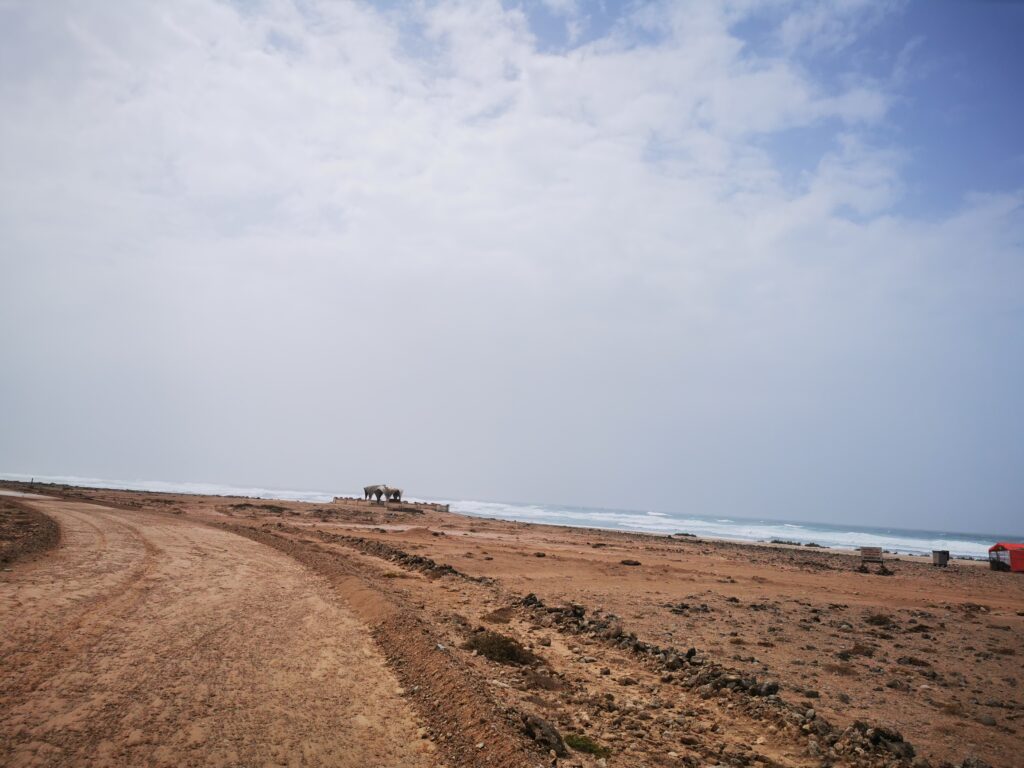

It was absolutely worth it, but no single soul around – as I found later out there was a reason for it. I continued with some water here and there, but overall no problem.

In this section every now and then the road had a lot grate like bumps – with bike going like ‘da da da da’ – here I lost and found my phone two times – so just make sure you don’t have loose objects that can easily disconnect – like a phone from its mount.

Some small water came back on the road but it was all very solid with gravel, so smashed through it easily (after confirming first indeed that it was hard ground – stopped the bike walked through it – I really did not want to get stuck here in the middle of nowhere, so just to be sure it was good to check just in case).
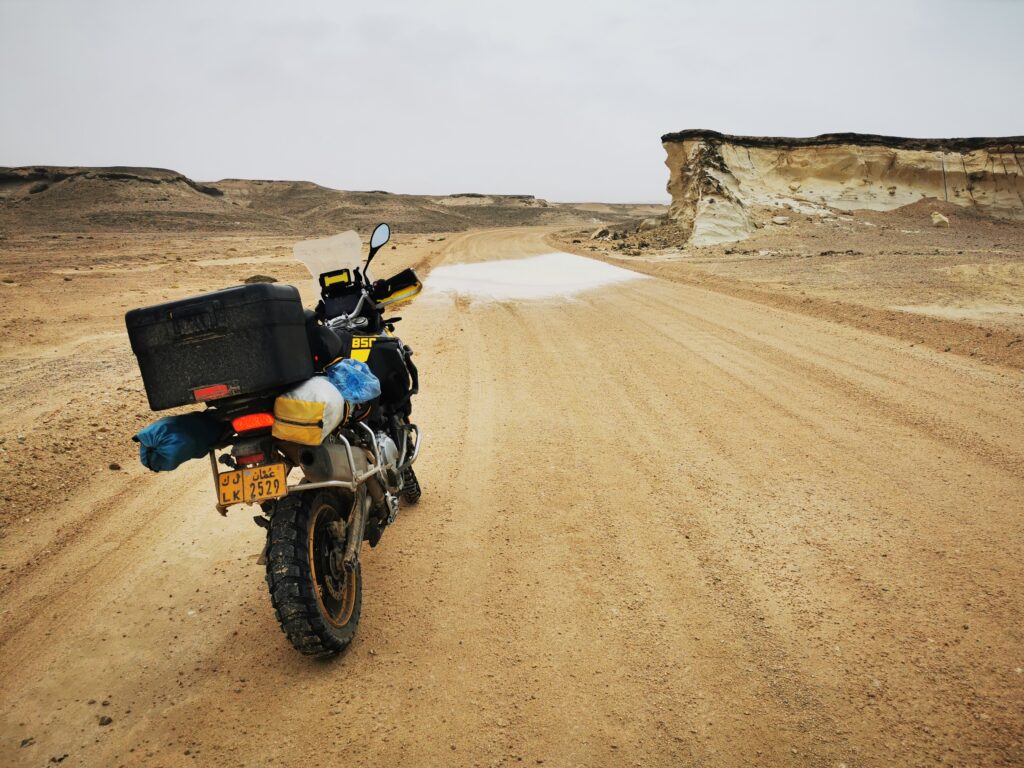
Then I reached this point:
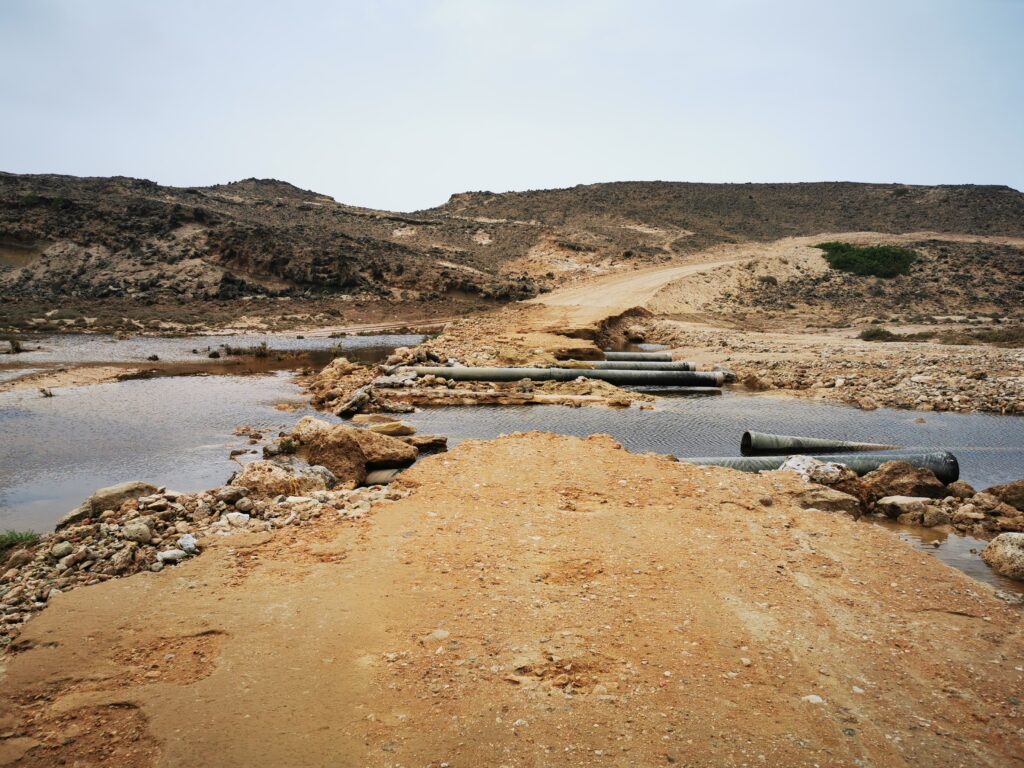
Later on when I checked with Artur and Darek the road was perfectly fine end of last year, so it must have been damaged during recent rainfalls.
Since I can’t go straight (no ramp to jump this over… just kidding) I thought let me check the options on the right and left.
On the right it looked like this:

The water section itself was full of rocks, but shallow. Rocks were size of the baseball ball largest, so I could easily cross that bit. However, the problem would be getting to that middle section due to quaggy mud and then getting on the main road at the end would be impossible due to the very steep slope and a lot of mud there.
Then I checked the left hand side:

It had much more water, but it was much more leveled with entry and exit points.
So a bit of risk assessment for the next decision: going forward or return back? The time was early, just before noon and I had plenty of fuel, so there was no rush.
I thought let me check the depth of that water and ground stability, so boots off and flip-flops on to ‘test the water’.
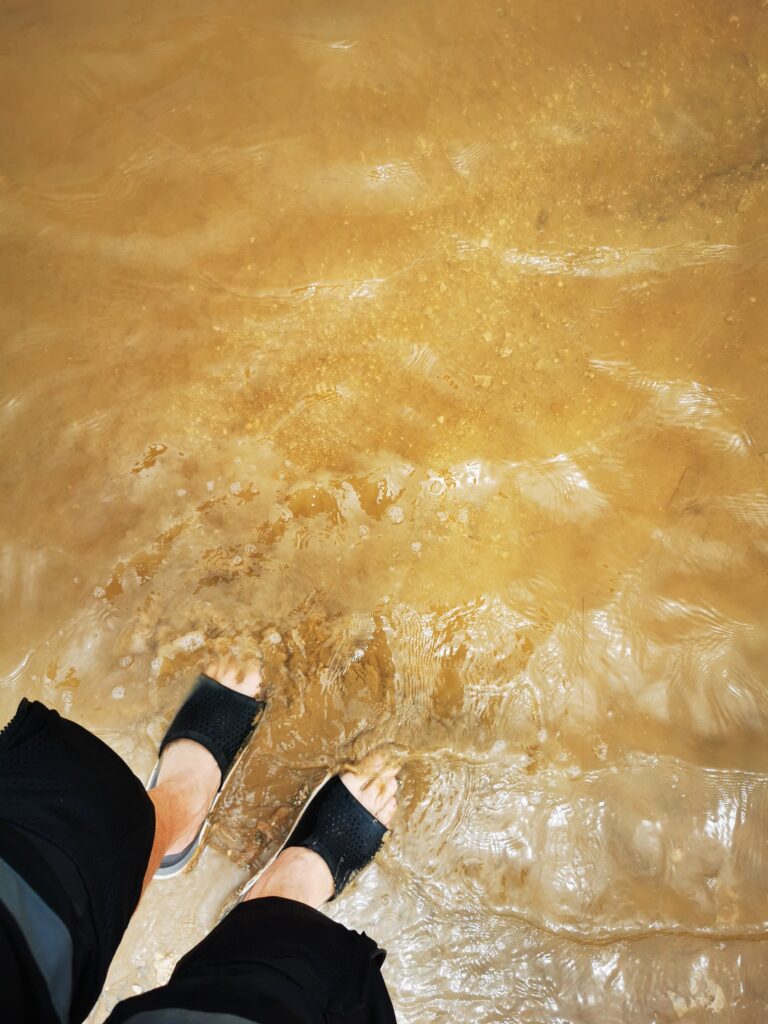
It turned out to be pretty stable with deepest place just below my knee. It was a mix of mud with small rocks. No problem to ride that through – I thought. The biggest uncertainty I had was whether I will be able to exit to the main road at the end of the water given mud and slope there – if the bike falls down I would not have much options other than going back into the water. So I cleared the mud a bit with my feet on the exit slope – just to remove that most slippery first layer. It was a short section, maybe like 3 meters, but slippery and uphill.
With that, I was pretty confident I could pass this through, but before making a final call going back to the risk: I reduced the probability of getting stuck but what about the worst thing that can happen? I looked at Google Maps (weak but present mobile reception, make sure you have all your maps available offline) and I saw closest village some 8 km away, so if I get stuck and cannot move the bike, then, in the worst case scenario, I would just have to walk there to seek help which would not be nicest, but 1.5 hours and I would reach there.
If that’s the worst that could happen, then let me go for it – I thought!
While browsing the map I saw there is another wadi after this one, so immediately thought – Ok I will cross this one, but if the next one is worse than this and impossible to cross with the bike – what then?
Then I noticed a relatively fresh car tracks on the ground indicating somebody was coming from the other end and reached the point where I was about to be after crossing, but hesitated and turned back. This meant that this person crossed that wadi ahead of me, but stopped at this one. With this, I deducted that the next wadi crossing needs to be easier not more difficult.
This tipped the scale to go ahead! I was a bit tired at that point walking back and front in the mud, so I went to the bike and wanted to reposition it and then while I was doing so, the stand closed on a rock and bike fell down and I, at the same time, cut my left foot big toe on a rock. Never move your bike on rocks in flip-flops!
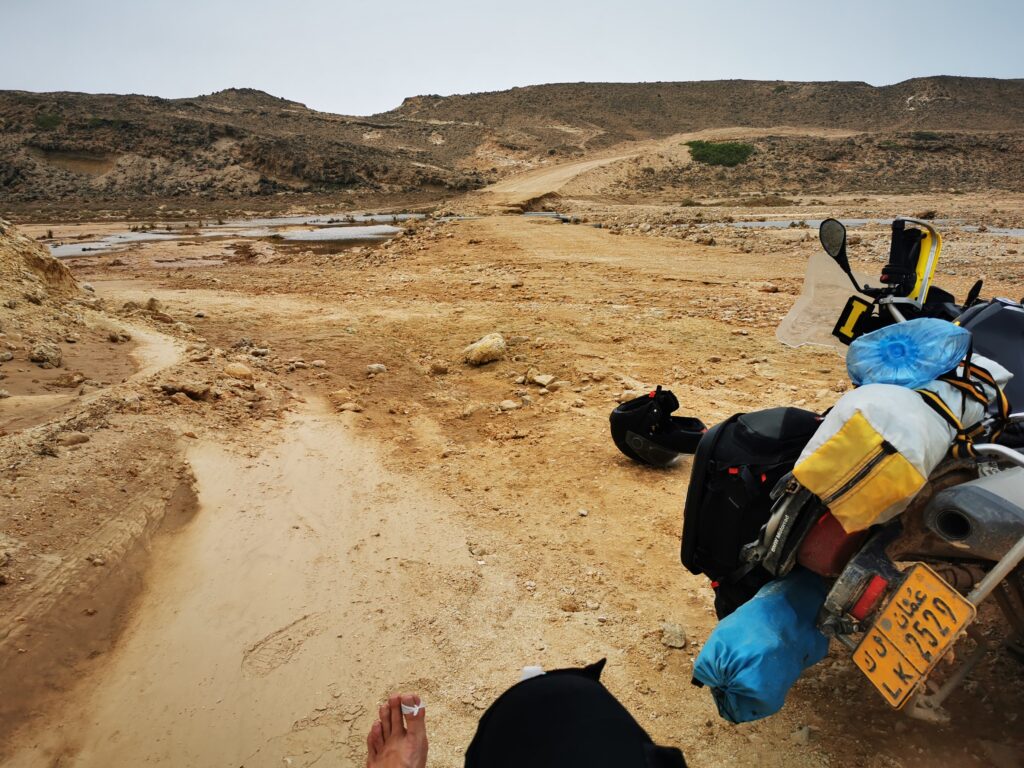
At this point I was like ‘everything is going wrong’: I am bleeding, road is damaged, bike fell off and nobody around – it can’t be worse can it?
Some blood came out, but fortunately it was a shallow cut. Thankfully, I had a first aid kid, so cleaned and put some bandage around the cut.


The worst thing was that if I cross it successfully I will have to walk in the muddy water back to get my luggage and may get some bacteria into the wound – no choice, I will disinfect the toe once I get back to civilisation I tought. Another tip: have a disinfectnant spray/liquid in your first kit, mine did not have it!
Having unloaded the luggage, with boots on, I finally went to attempt the crossing.
Bike died on me a few meters into the water, but thankfully it started and with a few leg pushes I was able to continue into the water. I crossed and found myself on the other end. Happy and proud of the achievement! I went back for the luggage on the other side (back to flip flops and back to boots again) and continued riding.

I was curious if my theory about the size of next wadi was right. It was. Here it is its picture, really nothing and easy to cross:

So I continued and then just before the Sharbathat village I met some locals – it was Sadu and his two friends – they invited me for grilled fish, but we had to go back the route I came from as they thought there was a place some people were grilling fish there. Since we could not find it, they invited me to meet their family at the Sharbathat village where I had goat and Omani coffee with their extended family in their house – again people I have never seen before – Omani hospitality at work again.




It turned out there is a clinic in the Sharbathat village. I went there with Ali to get some disinfectant, but it was closed. We called both numbers mentioned on the door, but both of them were switched off. In case of a real emergency possibly not the place where you want head to knowing this.
Then I had a plan to ride to Ras Madraka and camp there overnight, however the wind was so strong that from Ras Madraka I rode north to Duqm where I stayed overnight in a hotel.


Since this was a first time going in such a strong wind, here is what I learned. I was lucky as the roads were pretty empty, so I had enough space and time to get accustomed to this condition.
What I learned about riding a motorcycle in a strong wind?
- First of all, southern Oman experiences some pretty strong winds – now I know this! If you look at this annual average wind power map from https://globalwindatlas.info you will notice that there two areas with particularly strong winds. One between Mirbat and Ash Shuwaymiyyah and the second one between Ras Madraka and Duqm.

During my ride, it was almost the same as on this map with exception that wind was much stronger already before Ras Madraka. I checked and the wind speed on that day was between 40 and 45 km/h in northern direction.
- Secondly, the impact wind has on you, primarily depends on your angle with respect to the wind direction. When you ride in the same line as the wind direction there is no problem at all and when it is blowing on your back you don’t feel it at all. It is like you would be going an a calm and quiet day, see graphic below.

However, immediately when you turn and become more perpendicular to the wind direction, the battle against the wind starts. I experienced this very clearly when turned right at the round about towards Ras Madraka. From the calm and quite ride, I suddenly had to fight hard to stay on the road. First thought was: how come the wind occurred so suddenly, but in fact it was always there, but I wasn’t feeling it going in the same direction.
This figure below is trying to exactly reflect the location and condition I faced when turned right towards the Ras Madraka.

In summary, below picture demonstrates the idea of what to expect given certain wind direction.

After some time, I found it useful to know the above and was trying to use it to my advantage while learning and improving on the way.
- Thirdly, it is important to pay attention to wind direction when passing by oncoming trucks. In the first situation, when there is strong wind from the left (like it was when I was going) a calm area is created behind the truck as it is blocking the wind. This means that when you pass by a truck, you have two points where the wind direction changes significantly and suddenly which makes your bike wobble as shown in figure below.

My approach to maximize the bike stability during those two wobble points shown above, was to just before the truck was close by to reduce the gear, lean forward on the tank and open the throttle. This made me less of a sail and gave the bike more momentum to go through the wobble points in more stable way.
When the wind was from the right hand side there was no wobbling at all, so there was no need to do anything special other than battling with steady wind as show in figure below.

- Fourthly, when overtaking trucks and other vehicles (in windy conditions or not) don’t get too close and start overtaking early to avoid being caught in turbulent air flow formed behind them. This may make the bike to wobble too. I noticed this effect was stronger at higher speeds and larger vehicles of course and in during stronger gusts.

From now on, wind became a new weather parameter in addition to temperature and rainfall to check before heading for longer rides. It was really, very, very valuable experience.
Just to capture a few pictures in Ras Madrakah – it was really windy there and a lot of green foam coming out of the sea, again it had its own beauty. I took a few pics and drove back to Duqm.


When on the main road I was met by Sadu again, he invited me (again) for some joint food in Ras Madraka, but since it was getting late I thanked him and politely declined and rode back to Duqm.

This was the longest day-ride where I clocked 623 km with some adventures on the way. I did not really have a chance to see around Duqm unfortunately, but was really tired that evening and went to bed early.

Day 4: Duqm to Masirah Island
After Day 3, I had a lazy morning and only departed Duqm at 8am. The plan was to catch the 11 o’clock ferry to Masirah Island from Shannah Port which was about 250 km from Duqm. Again magnificent ride on that section, beautiful empty spaces with nothing but some camels around and no wind this time!
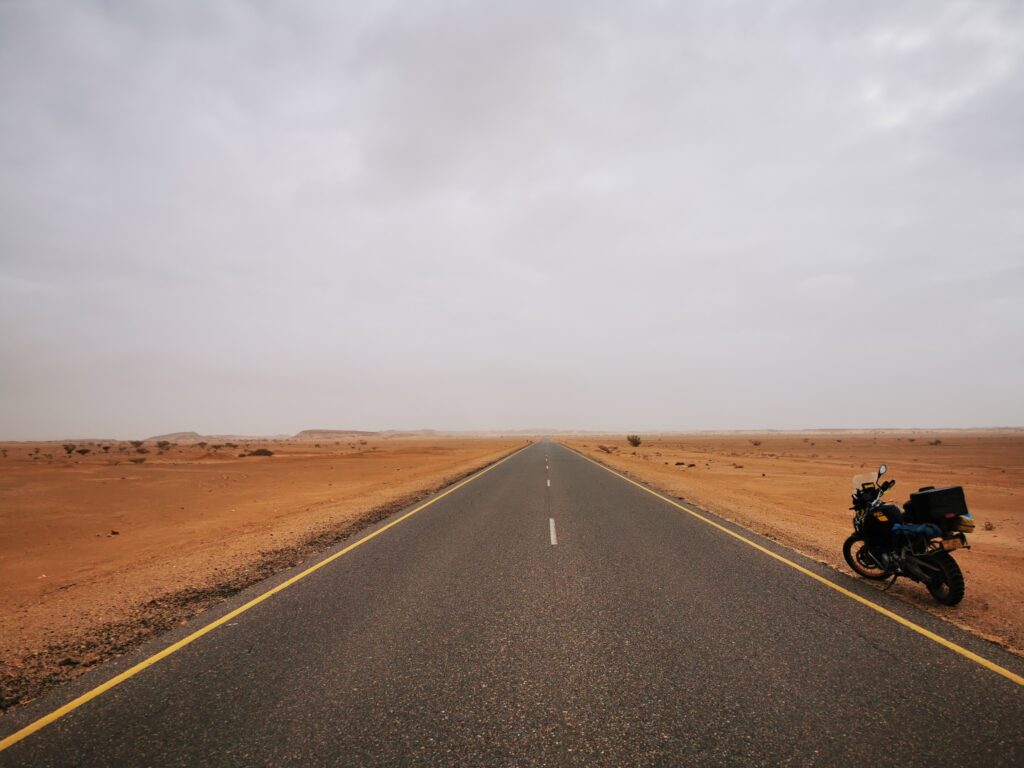
Not picking up too much speed as occasionally water was entering the road.

After adventurous Miji loop the day before, I spotted a similar loop off the road 32 via Filim before reaching Mahoot, see map below
So I tried it, it continued as black top with a few dunes slighhly entering the road all the way until the first T-Point.

But then at the junction it became offroad like this:

Again, a risk based decision was pretty straightforward here: I rode a few meters and it became very sandy very quickly – getting stuck somewhere along the line was 100% guaranteed – I thought. With no soul in sight, I called this one off and went back to the main road.
Crusing along the road I saw more water which could have also been watinig for me had I gone through that sandy road towards Filim. Again reafriming a good decison taken minutes before.


Eventually, reached Shannah Port to catch the 11am ferry to Masirah Island.

I paid 15.6 Rials for a return ticked including my bike at the National Ferries Company.
I walked out from their office and I saw a guy parked his car like this:

This just tells me that it is a long, long time before bikers will be seen by car drivers as equals… Anyway, I talked to the passenger and he moved the car, so I could catch the ferry which was about to depart in 15 minutes.
Here is the Ferry schedule between Shannah port and Masirah Island in case someone finds it useful:

The sea was pretty rough, but the ferry looked big and pretty well maintained.

It was pretty comfortable inside with a lot of space. But no food or hot drinks just water. I would have really welcomed something hot to drink then…

Again, be careful riding up the ramp as it is covered in this sandy thinny layer so it is easy to loose traction. Folks on board helped me strap the bike up and off we went to the Masira Island!


It was about an hour journey, so I used this time to check the tyres for any damage and also inspected the chain.
That water I went into the day before was pretty salty I think, so I decided to fully open my chain oiler to soak the chain in oil and minimise corrosion attack by the salty water.
I bought this automatic chain oiler shortly after I got my bike and honestly speaking until this trip I could just do without it by simply cleaning and oiling my chain before or after trips with some manual sprays/oils. However, this was the first time I did not have any oiling stuff and I needed it and with oiler I just turned up the dial and after a short ride the chain was back in good shape. Good investment for longer trips I think unless you want to carry some oiling stuff along with you and do chain maintenance on the road, especially after riding in some sea water.
Here the chain back in shape:

Once on Masirah my plan was to do a round trip first, then find a place to sleep and next morning head for Muscat. Eventually, I took the 5pm ferry back to Shannah Port and slept there. For more details see the maps at the end.
As I was going around the island I spotted a lot of kitesurfing places.

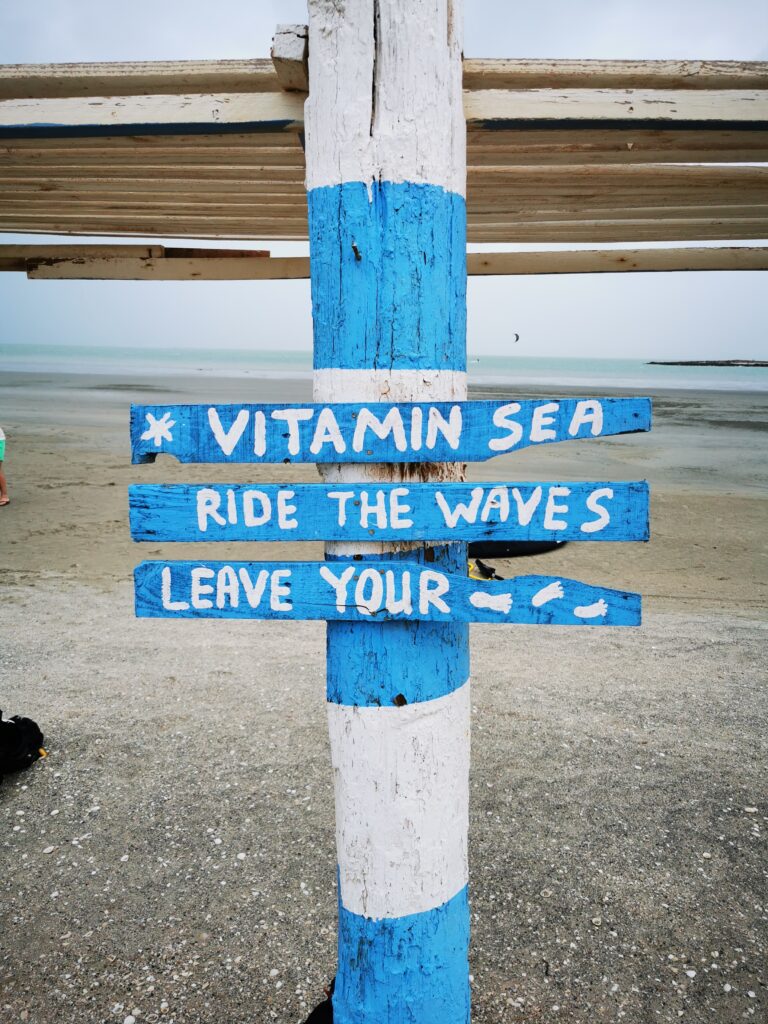
At the first spot called Masirah Beach Camp, you could rent a hut for a night (with or without AC). I did a little wheel spinning there on the light gravel, had some coffee, chatted with the owner and continued along the round the island route. The wind was moderate, but still some strong gusts every now and then.


They had this very interesting ash tray there…

Along the route, I spotted this construction a few times which later on I was told is used to aid slaughtering process.

Hey! where did these guys come from on the Island…?


As I was driving south the sky continued to clear up revealing different colors of the island.

There were I think 3 kitesurfing spots on the western part of the island. I stopped at each of them and had a few chats with people. It turns out this place is really popular among people from Europe. And you can learn kitesurfing by taking a course.
One of the spots had primarily wind surfers and no kite surfers.



Along the road it was very easy to take a side route offroad and have some more of nice views, especially towards the southern cape of the island. As the sky continued to clear up, the sea became more and more green.



As I was going around the island the black top suddenly turned inland whereas my Google Map was showing that I needed to continue going straight. It turned out that in order for me to continue along the coast I needed to go offroad again, so I went off the black top looking for the road.
It looked like this:

I walked on it for some 100 meters to see if I can make it – I really wanted to along the coast.

But it turned out to be very sandy and not just at a few points, but continuously.

So 100% I will get stuck if I go this road – I thought and also at the tip of the island there were no souls in range. So decision was not to try it and continue inland on the black top.
Then, suddenly, out of nowhere a pick up with 4 Omanis showed up behind me! So I asked them if they know this road and would be willing to go with me and help me in case I get stuck. Before I finished my sentence they were already fully into it and driving the road ahead of me!
Having a pick up truck with 4 people in it brought the consequence of the worst case scenario to almost nothing, so we went!
Oh yes there was some water at the beginning, but I managed to circumnavigate it.
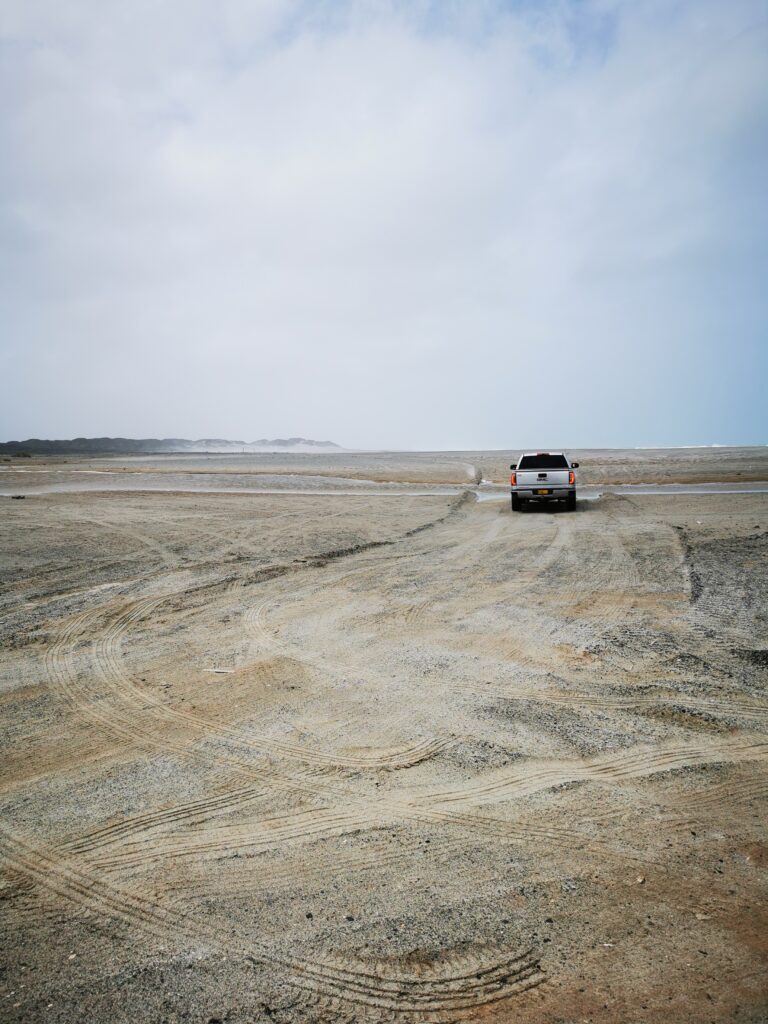
I was so lucky these blokes turned up, otherwise I would have missed such a great experience.

The ride was actually pretty difficult as it had long, deeper sand sections, but amazing to practice with stunning views – it does not get any better than that!
It was not without falls too… just one actually.

But we continued…
I was so happy to have made it. Would I have made it without these folks? – probably yes, but who knows… I thinks some luck helped me too. As I mentioned earlier, the challenge I have with riding on sand is giving the bike too much throttle with too little speed I think, so more to practice… but this was such a fantastic experience.
After this, the rest of the island was a piece of cake. I managed to get to buy some fish for the ferry, get to know some of the ferry folks and at 6pm was back at Shannah Port.


The Shannah hotel turned out to be pretty Ok and it had all I needed at that time including a towel and sea view.



The beach at Shannah was very polluted with plastic debris:

After sitting on a bike for 4 days, I took a longer walk before dashing off. There are two restaurants at the port which I think are pretty ok. I think they are used by the fuel truck drivers whom I saw staying there overnight at the port. Truck drivers won’t get satisfied with any food, so usually their sign indicates good cuisine. Yes there is a gas station at Shannah so you can fill up there.

Before going to bed I tried to position the bike around the building to minimise wind blowing on it from the sea.
Day 5: Shannah Port to Muscat
Last but not least! Day 5 started pretty early, just after 5am I was on the road as I wanted to reach Muscat that day and I was not sure if I had to take some round routes as some of the Wadis entering the sea were reported to have overflooded.
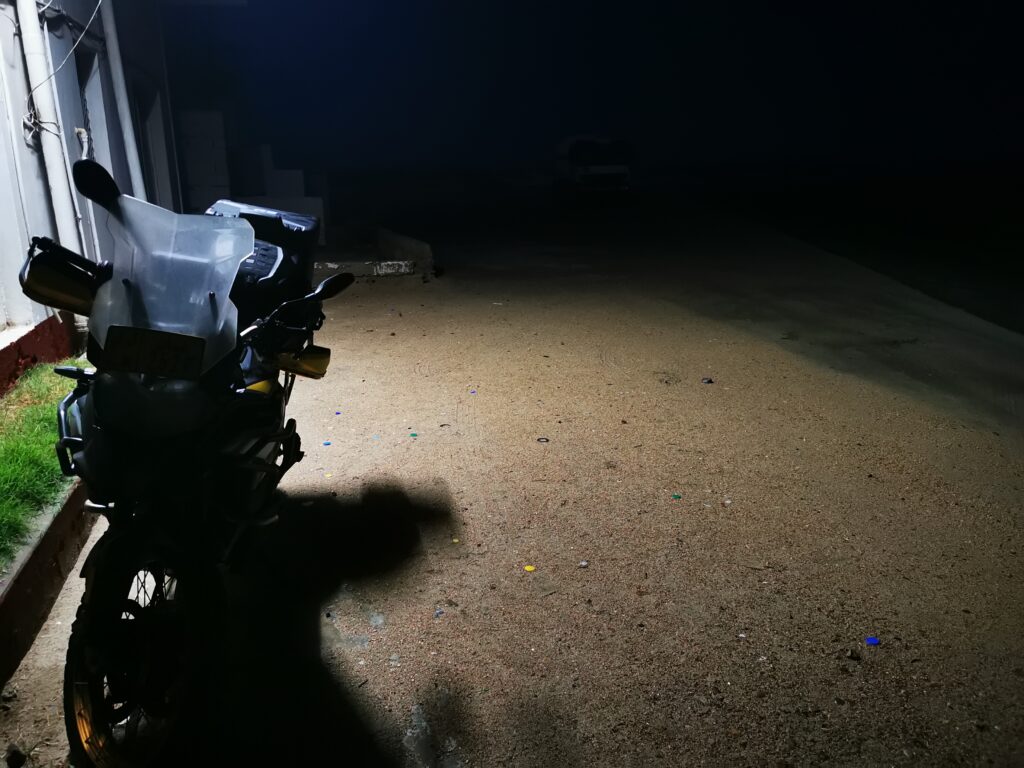

As I was going, one strange thing kept me thinking. Once or twice I saw a village with similar buildings in the middle of nowhere like this one:
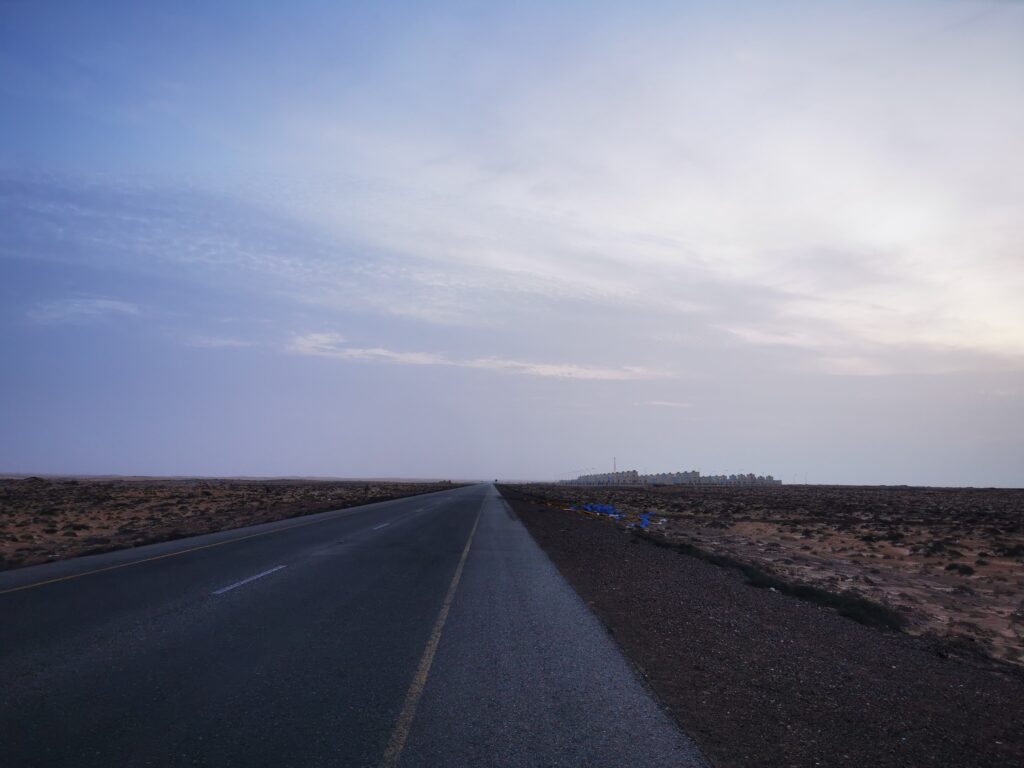

There were just these houses there and no other buildings, no cars. Maybe some investment but strange, in the middle of nowhere.
Then also saw these barracks in the middle of nowhere, not sure what those are.

As I was going for miles on empty road some traveler camels appeared. It seems, those guys like to keep moving too!
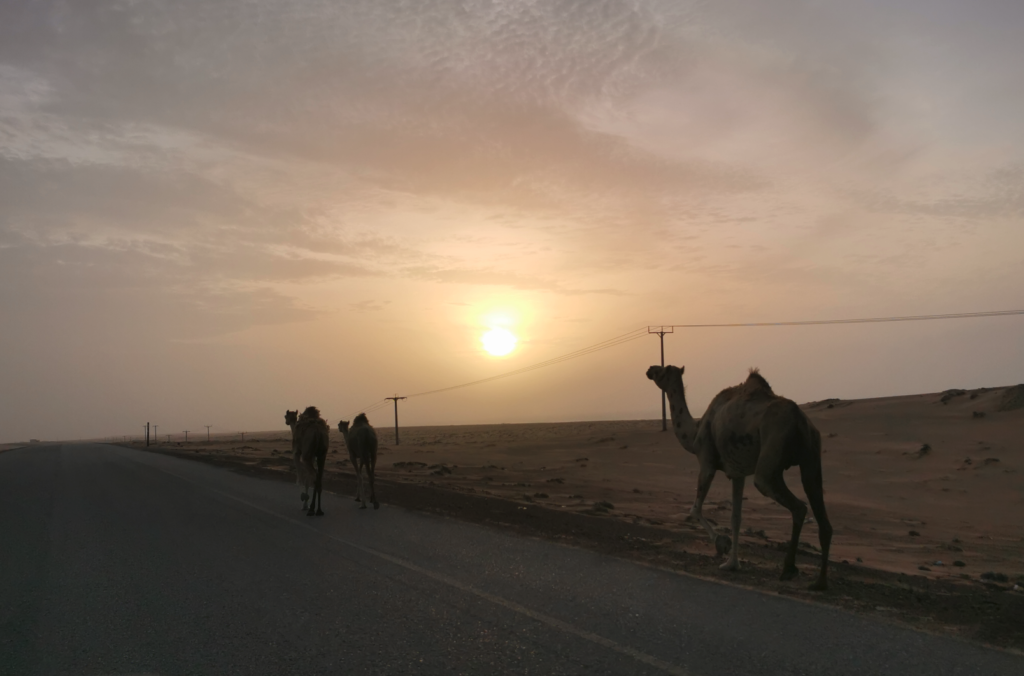
I continued the ride with some occasional water on the road – nothing serious, but you need to slow down for it.

Then nice and long stretches…


These huts below were a nice patent to hide your tent from the wind on the beach…

Just before 7am I stopped in one of the villages to eat some breakfast and found this fantastic bakery.

They had these nice warm buns with different fillings, I really enjoyed it! Believe it or not but cost of one piece was 1 baiza only!



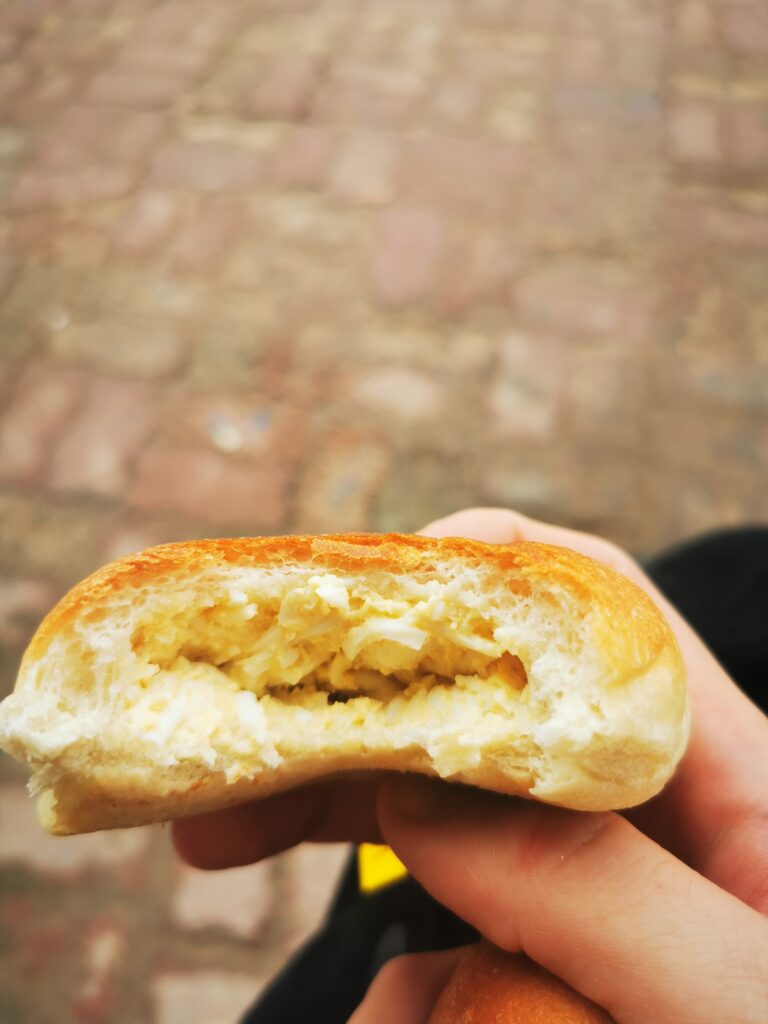

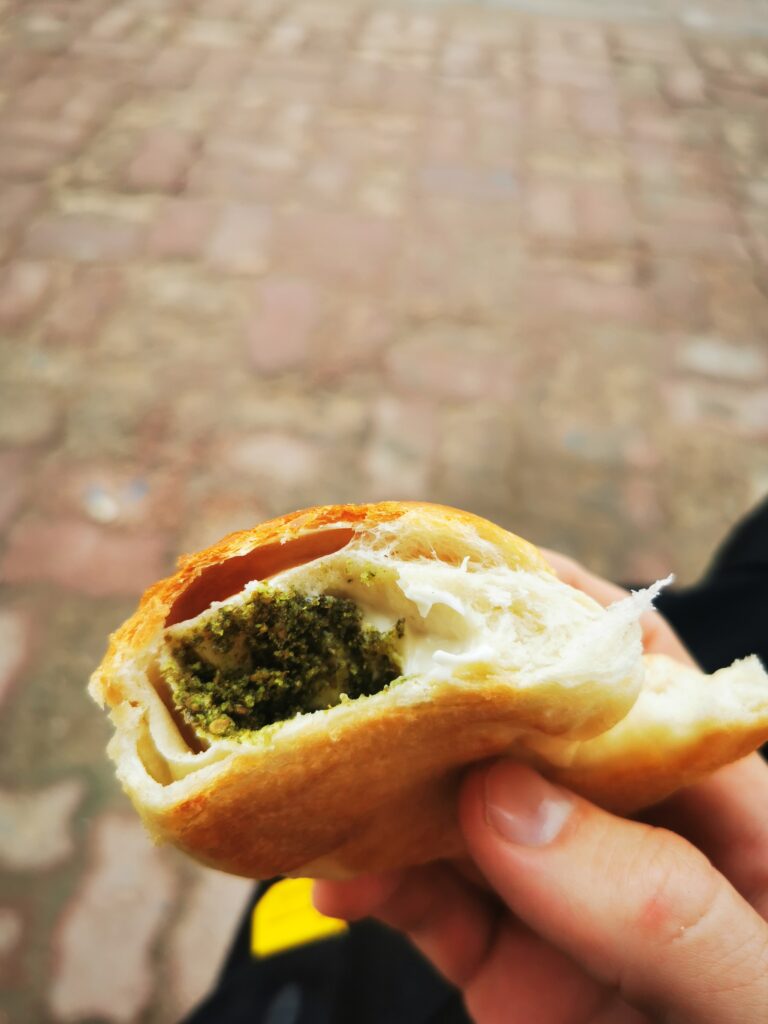
With tummy full I continued.
On the map there was one Wadi that looked big enough which I was not sure would be flooded or not.
Fortunately, it was one of those wide ones where the water has a chance to spread, so the level doesn’t build up. Having seen this I knew the rest of the route home will be easy.

Along the route I stopped to check out the Pink Lake, but there was nothing pink about it – I guess the day was too cloudy for the light to expose its beauty.

Then I continued riding and just before the Turtle Reserve I noticed a camper at the edge of the cliff, so I went there to say hi. It was a lovely couple Said and Julia who come there every month for a week and clean turtles’ beach from plastic. I was shocked that despite them cleaning it every day for a week every month the sea keeps bringing more and more of plastic.
We had a lot of great conversations accompanied by their freshly roasted and freshly ground coffee… mmmm it was so good I still remember its delicate but strong taste.




After enjoying the coffee it was my turn to help to clean the beach… at least this little I could do then at moment.


It took me some 40 minutes to fill up the bag full of plastic waste and there was plenty left, even though Said and Julia collected two bags already in the morning. The sea just keeps bringing it again and again.
I found all kind of staff there ranging from bottles through shoes and all sorts of packaging material to some houselhold equipment like window cleaner. Here is the gallery. I think it is important for people to see this.









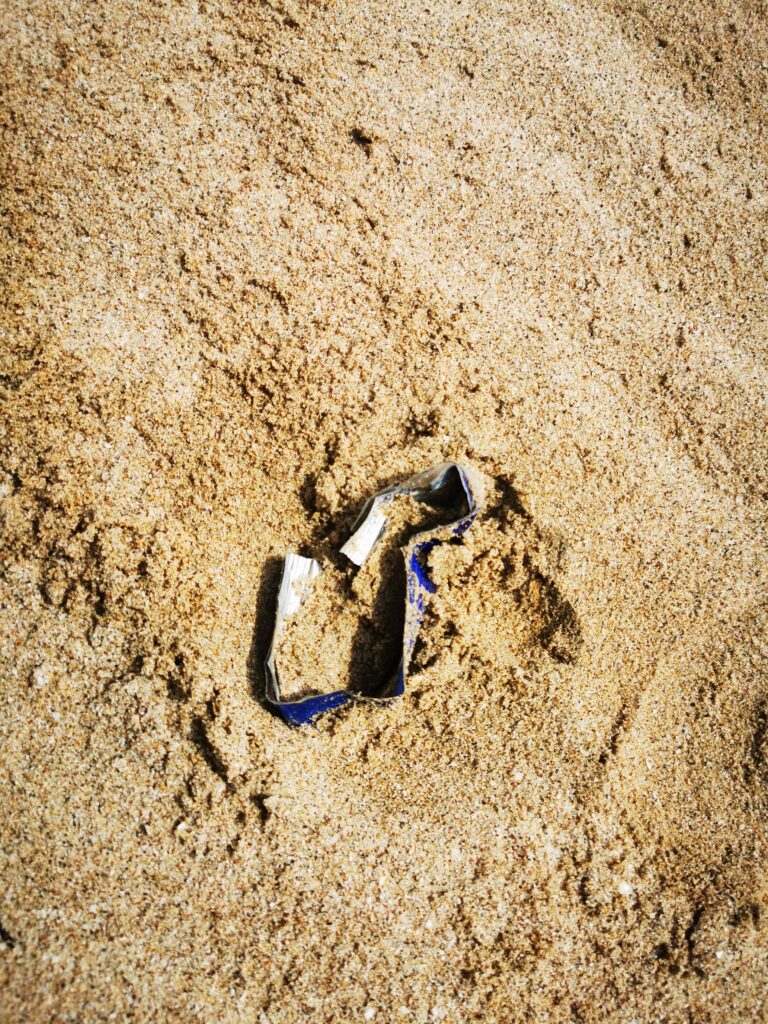








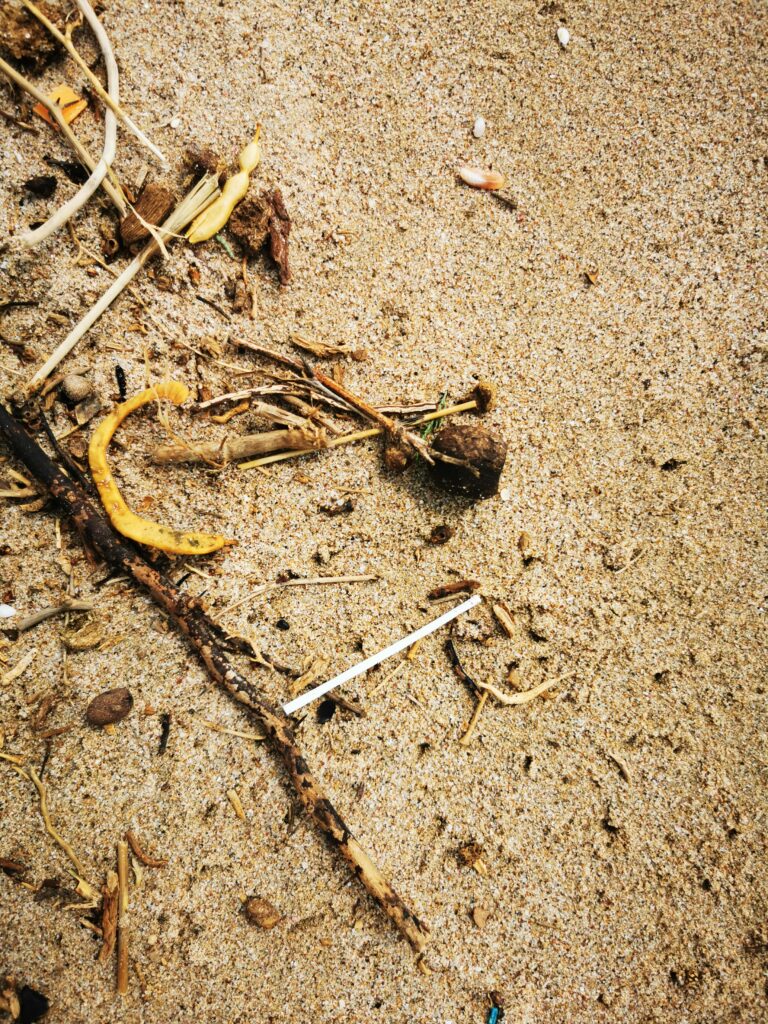










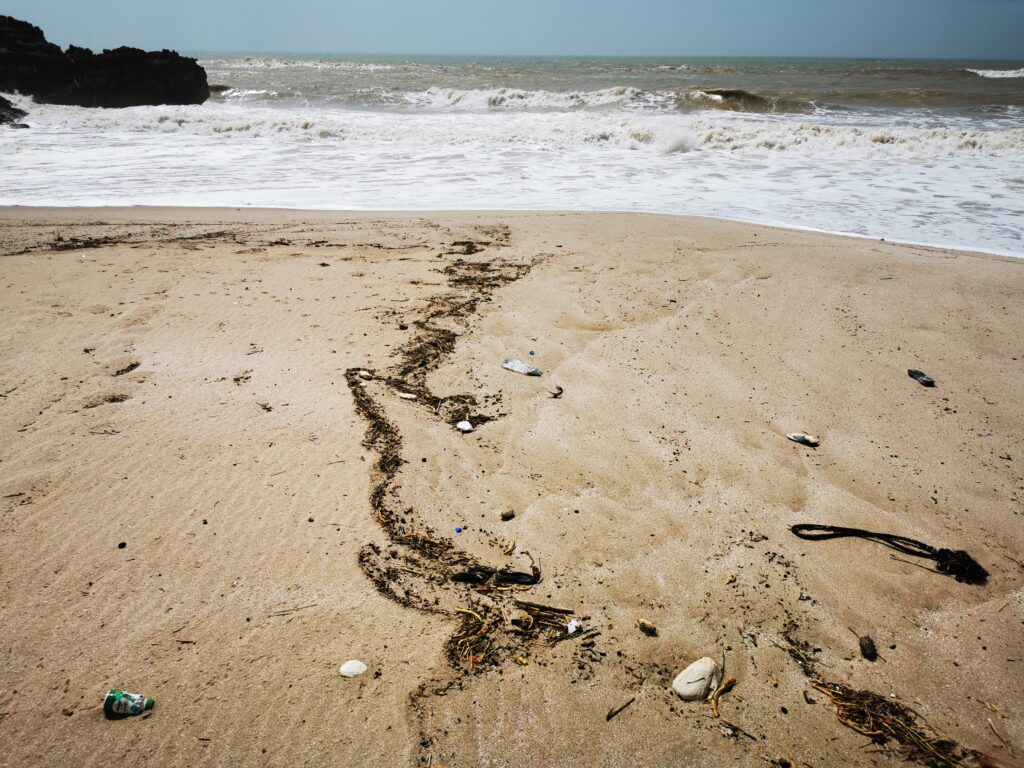
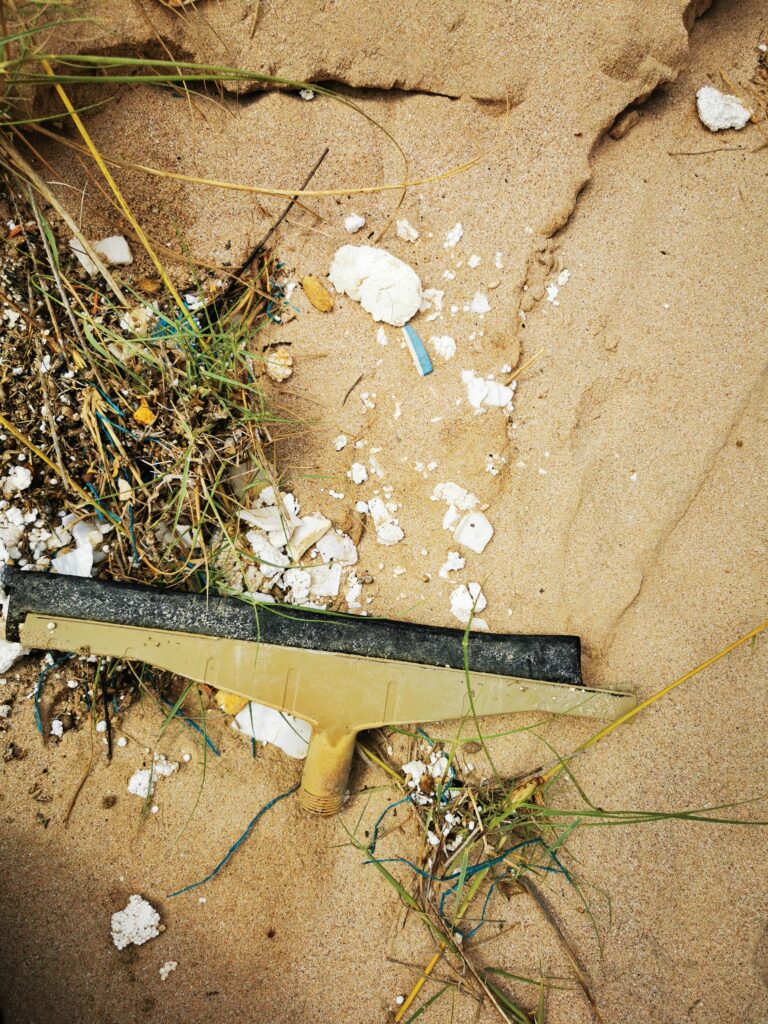
Some of this plastic waste was just next to the turtle’s nest, so the first thing the young turtles will see after they hatch is some of their descendants fossilfied and turned into plastic, although with different colours. This was really sad to see…
Cleaning the beach of course is not addressing the cause of the problem, but at least one or two turtles more may survive. So greatful to the fantastic people like Said and Julia for doing this kind of work because they know it is a right thing to do.
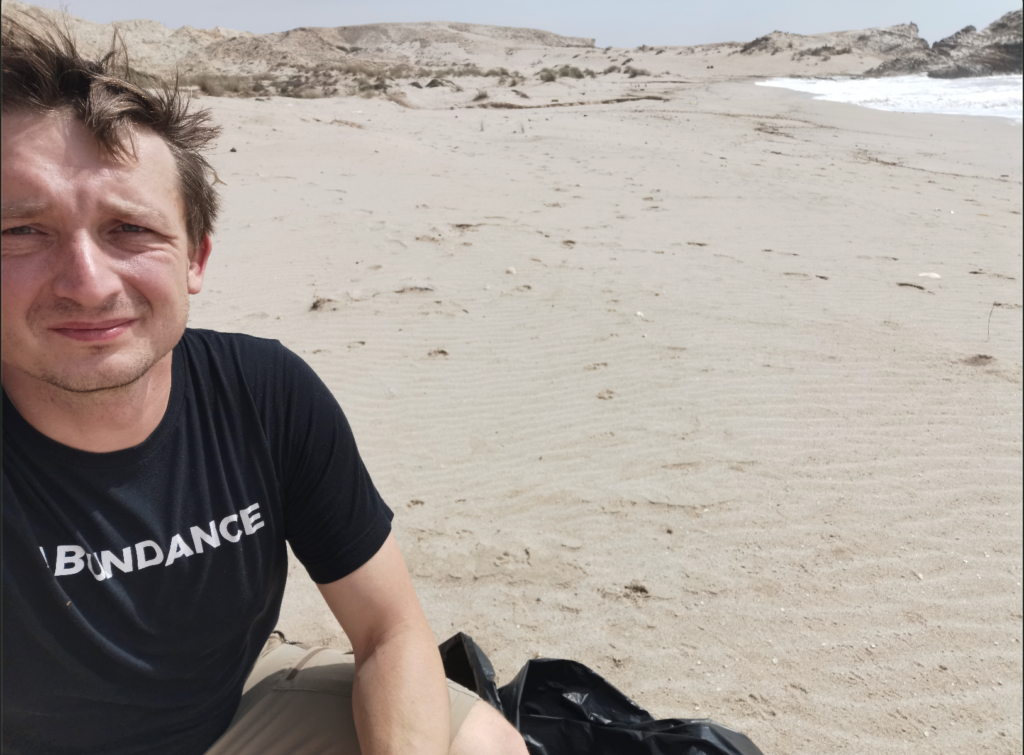


Just around there I found some hidden ‘geisers’:
Having said bye to Said and Julia, I continued towards Sur, the temperature was still below 30 degC but it was increasing.
In Sur, I entered into a mini shipyard that is nowehere to be found from outside, but coincidently, I saw a French family entering there, so I followed them.

In addition to a full-size ships, they were also making mini models, pretty cool.




Although seeing this mini shipyard was intersting, it was a mistake to enter the city as the temperature reached 37 degC and with number of traffic lights and no wind it was getting too hot. Fortunately, when I left Sur the temperature dropped to 33-34 degC. This is by the way the highest limit under which riding on a bike is still comfortable for me. Above this, it is still doable, but it becomes much less of a pleasure, at least for me.
On the way back, I checked all possible Wadis for flooding.




The worst situation was at Wadi Shab, crossing of which was closed by the police. All the others were with increased water level but crossable.
Then I went to Fins village and continued riding a small road along the highway all the way to Dibab – it is a lovely route for a motorcycle and a great alternative to the parallel highway, also being closer to sea it was some 2 degrees cooler.
As I was driving there I was accosted by two Beligan students who were doing their around the world tour. They just came back from Qatar and Emirates and were stopping over in Oman before heading out to India. We had some chats about own traveling experiences and parted at the Sink Hole attraction.

After that, I rode straight back home and that was the end of the 2100 km 5-day trip from Dhalqut to Muscat. I truly enjoyed the experience and wish all the new riders that their trips are full of adventures and have safe returns.
Ride safely,
Lukasz
If you liked the story and have any comments put them down below. Please forgive brevity sometimes, typos and any mistakes.
Pretty happy with my BMW F850 GS – it did a pretty good job in all sorts of conditions with heavy load! Bike I know I can rely on.

Below is the full map (blue colour) including BMW Motorrad app track (red colour) where the App was on.
Link to the map:
https://www.google.com/maps/d/u/0/edit?mid=1j92mQ-oghLzo0GU3Rbk7Cqt2B2XbhgU&usp=sharing

4 responses to “Five days motorbike ride along the coast of Oman from Dhalqut to Muscat – July 8-12th 2022”
Hi Łukasz,
This is really nice story, I see you enjoyed it a lot 🙂
You are good story teller, I felt like I was also on this trip. This reminds me my last year trip also to Salalah by coastal road – it was really amazing route with a lot of nice views all over the way.
Next time I recoommend you to try just after Khareef, then still everything is green and there is no fog, so you can see more nice views.
Nice detailed trip I really enjoy it specially shuwaymiyah and dhalkut, These adventures give you inspiration, improve behavior and character, and show you the world from another angle
Amazing trip with all this powerful adventures , you are hero brother . Avery organize essay and very useful information shared
Dear Lukasz,
We was glad to see you and most happy to get your help for beach cleaning.
Hopping to meet you again.
We read your blog and it was full of joy, adventure, information, inspiration and motivation.
Soon gona get a bike, hehe.
thank you.